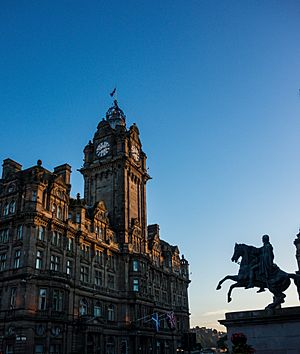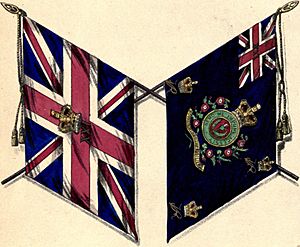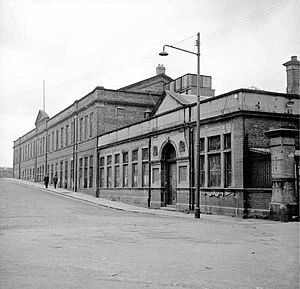North Britain facts for kids

Across the street is a statue of Arthur Wellesley, 1st Duke of Wellington, a famous general who won the Battle of Waterloo. Scottish soldiers, known as the Royal North British Dragoons, were part of his army in that battle.
North Britain is a name that was often used, especially between the 1600s and 1800s. It referred to either the northern part of Great Britain or specifically to Scotland. Scotland makes up the northern third of the island of Great Britain. People from Scotland were sometimes called "North Britains" or later, "North Britons."
This term had partners: South Britain usually meant England and Wales. And West Britain was often used for Ireland.
Contents
Why the Name "North Britain" Was Used
The name "North Britain" started appearing after 1603. This was when the crowns of the Kingdom of England and the Kingdom of Scotland were joined together. This event is known as the Union of the Crowns.
At first, "Britain" could mean either the island or a person from Britain. So, "North Britain" sometimes meant a person from Scotland, just like "North Briton."
King James VI and I was the first king to rule both England and Scotland. He often used the terms "South Britain" for England and "North Britain" for Scotland. A famous example is his royal order in 1606. This order created the first Union Flag. In this order, he didn't even use the names England or Scotland, only "South Britaine" and "North Britaine."
Whereas, some differences hath arisen between Our subjects of South and North Britaine travelling by Seas, about the bearing of their Flagges ...
King Charles I repeated this idea in 1634 when talking about the flag. He added "England" and "Scotland" to make it clearer:
Our further will and pleasure is, that all the other Ships of Our Subjects of England or South Britain bearing flags shall from henceforth carry the Red Cross, commonly called S. George's Cross, as of old time hath been used; And also that all other ships of Our Subjects of Scotland or North Britain shall henceforth carry the White Cross commonly called S. Andrews Cross.

After the Acts of Union 1707, which formally joined the parliaments of Scotland and England, Scotland was sometimes officially called "North Britain." For example, in 1707, a famous Scottish army group, the Royal Scots Greys, was renamed the "Royal North British Dragoons." Another group, the Royal Scots Fusiliers, also changed "Scots" to "North British" until 1877.
The famous Scottish writer Sir Walter Scott used the term "North Briton" in his 1817 novel Rob Roy. He used it to describe a Scottish person who was in England.
How "North Britain" Was Used in History
The term "North Britain" is often used when talking about history. It helps describe the northern part of Great Britain in a way that doesn't focus on politics or culture.
The name was very popular when the railway system was being built. The North British Railway was a major train company that ran from 1846 to 1923. It left a lasting mark, like the North British Hotel in Edinburgh, which is now called The Balmoral Hotel. The North British Locomotive Company also made trains from 1903 until 1962.

Many other businesses also used the name. For example, the Edinburgh North British Insurance Company started in 1809. The North British Distillery Company was founded in 1885 and makes whisky. The North British Rubber Company, started in 1856, was famous for its Wellington boots and later became Hunter Boot Ltd.
Sometimes, "North Britain" referred to the northern part of Great Britain, not just Scotland. For instance, the North British Academy of Arts existed from 1908 to 1924 in Newcastle-upon-Tyne. This city is in northern England, showing the term could cover more than just Scotland.
Newspapers and magazines also used the name. The North Briton was a newspaper in the 1700s. The North British Review was a Scottish magazine started in 1844. It was created by people who wanted a Scottish "national review." Another paper, the North British Daily Mail, started in 1847. It later became the Daily Record.
In the 1800s, "North Britain" or "N.B." was commonly used for postal addresses in Scotland. However, by the early 1900s, people stopped using this style. The matching term, "South Britain" for England, never really caught on.
"North Britain" Today
Today, the northern parts of Great Britain are sometimes simply called 'the North'. However, this term is more often used to describe northern England. This usage often comes up when people talk about the idea of a "North–South divide" in the UK.
In 2008, some universities like Aberdeen, Edinburgh, and Heriot-Watt University held a "North Britain Student Forum." This meeting focused on topics like geoscience and engineering.
Images for kids


